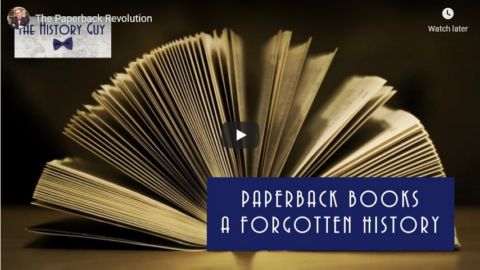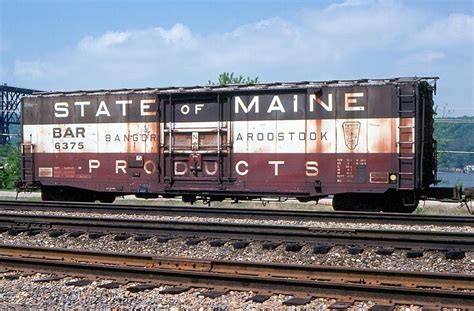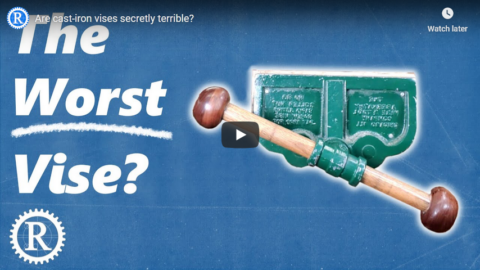PeriscopeFilm
Published 24 May 2020Want to support this channel and help us preserve old films? Visit https://www.patreon.com/PeriscopeFilm
Visit our website www.PeriscopeFilm.comSanta Fe presents, Loaded for War. This WWII era color film presents the power of the Santa Fe railroad. While speaking of the mighty effort the trains and its myriad workers achieved during wartime, the footage is all modern and in color. The film does a great job of showing how integral our railroad system has been to the growth of these United States. “With grateful appreciation to the Office of Defense Transportation, the Army, Navy, Maritime Commission, and the shipping and traveling public, for the cooperation and genuine understanding which has made the service record here presented possible …” The film opens with a steam locomotive bearing down on the camera 1:03. The narrator speaks as the train crosses a trestle 1:10. News headlines of December 7, 1941 11:25. Steam and diesel locomotives are transformed into machines of war 1:40. Smoke fills a train yard as trains enter and are washed 2:08. A train signal shows a green light 2:25. Workers are seen in the factory 2:36. Civilians exit trains volunteering for service 2:45. A telegram is shown stating that the trainmen should, “move all available equipment to military stations without delay” 2:54. Four locomotives are shown 3:03. Crews are assigned and men work double shifts 3:45. Rail equipment is loaded by military personnel, ready to move 4:13. Flatcars are loaded with tanks and military trucks 4:52. Divisions of fighting men aboard the trains 5:09. The tanks roll down the tracks on flatcars 5:35. The wheels of war are rolling 6:14. The day by day mass movement of freight is shown at the train yard 6:48. Trains crossing country on railroad tracks 7:40. Trains service the shipyards as men work building military ships 8:00. A ship is launched 8:15. Cattle and pigs are delivered throughout the 48 states 8:37. Potatoes are tilled in the field with heavy equipment 9:00. Oranges are picked and packed in southern states 9:13. Military bombers soar through the air 9:23. Heavy machinery workers in the factories 9:48. Factories and men building artillery shells 9:55. Tanks roll off the product line and onto the railroad tracks 10:10. Locomotive struggles up a hill 10:25. Miners and their lamp hats head down the tunnels by rail 10:38. Oil fields are shown 11:15. Oil is loaded onto railway tankers 11:38. Machines digging the copper mines 12:08. The big diggers pick up 8 cubic yards of copper at a time 12:18. The railroad moves the copper to the smelters 12:31. Sulfur mines using forced steam 12:50. Sulfur is moved by train to the gunpowder makers 13:25. Logging industry is served with the railroads 14:00. Cotton and scrap metal industries are also served by rail 14:18. Old cars are being called back into use for the war effort 15:30. Locomotive number 3723 comes out of retirement by the trainmen 15:48. Various train parts are marked and taken away for repair or replacement 16:07. Men work in factories with fine-tuned machines to retool and refine old parts for new use 16:26. Old firebrick is removed and replaced 16:43. Acetylene torches are used inside the huge boilers 16:49. Huge wheels are cleaned and dipped and sprayed ready for use 17:08. Heat is used to expand the metals 17:18. Locomotive number 3723 is fully refurbished and ready for the tracks 18:05. All types of equipment need to be refurbished for the war effort 18:46. The men use heat and molten metal to reshape old parts for new use 19:00. Gears are ground with precision 19:13. The railroads motto, “let’s keep ‘em rolling” 19:24. The men work on building new track 19:35. Men using hammers to straighten out tracks 19:53. The towermen, bridge crews, conductors, station men, ticket men, dispatchers, signalmen and to the other thousands of men – give the railroad men their due 20:44. Women are also an integral part of the success of the railroad 21:07. The women work in offices but also in factories with heavy machinery and molten metal 21:21. Two women wash down a train 21:30. The wheels of war are rolling 21:40. Military men march in unison 21:47. Train caboose pulls away from the camera 22:52. A flag with 8057 turns into the American flag and waves in the breeze 23:06. The End. Santa Fe.
We encourage viewers to add comments and, especially, to provide additional information about our videos by adding a comment! See something interesting? Tell people what it is and what they can see by writing something for example: “01:00:12:00 — President Roosevelt is seen meeting with Winston Churchill at the Quebec Conference.”
This film is part of the Periscope Film LLC archive, one of the largest historic military, transportation, and aviation stock footage collections in the USA. Entirely film backed, this material is available for licensing in 24p HD, 2k and 4k. For more information visit http://www.PeriscopeFilm.com
March 15, 2021
Loaded For War — The Santa Fe Railroad In World War II
March 13, 2021
The Paperback Revolution
The History Guy: History Deserves to Be Remembered
Published 12 Mar 2021Sponsored by Blinkist. The first 100 people who go to https://www.blinkist.com/thehistoryguy are going to get unlimited access for one week to try it out. You’ll also get 25% off if you want the full membership.
Today, the most popular book format in the world is not a traditional hardcover book, nor an ebook, but a paperback — a format that changed the what, how, when and how much the world reads. It is history that deserves to be remembered.
This is original content based on research by The History Guy. Images in the Public Domain are carefully selected and provide illustration. As very few images of the actual event are available in the Public Domain, images of similar objects and events are used for illustration.
You can purchase the bow tie worn in this episode at The Tie Bar:
https://www.thetiebar.com/?utm_campai…All events are portrayed in historical context and for educational purposes. No images or content are primarily intended to shock and disgust. Those who do not learn from history are doomed to repeat it. Non censuram.
Find The History Guy at:
Patreon: https://www.patreon.com/TheHistoryGuy
Please send suggestions for future episodes: Suggestions@TheHistoryGuy.netThe History Guy: History Deserves to Be Remembered is the place to find short snippets of forgotten history from five to fifteen minutes long. If you like history too, this is the channel for you.
Awesome The History Guy merchandise is available at:
teespring.com/stores/the-history-guyScript by THG
#history #thehistoryguy #Books
February 19, 2021
QotD: The disillusionment of working in a bookshop
For the better part of 2006, while studying for a master’s degree, I worked part-time in a branch of Waterstone’s, in *REDACTED*, the county capital of *REDACTED*.
I got the interview by stating openly in my covering letter that I was 24, still living with my mum, and asking her for train-fare had become a bit undignified. This seemed encouraging. But then the panel (2 pax.) asked what I was reading currently, and I said Sam Harris’s The End of Faith, and there was awkward silence. This set the tone for almost every “literary” chat thereafter.
Call me an idiot, but I was genuinely stunned to find we weren’t allowed to read on the job. Instead, booksellers had to devote any time not spent actually dealing with customers (which on a rainy weekend, in the wrong bit of the shop, could be a lot) with often-fruitless searches for books which had been lost, mis-shelved, or maybe stolen, or because they had to be returned to publishers (another surprise), and at the publisher’s expense.
I also quickly realised that the layout of the shop was not an accident (even in the jury-rigged “commercial” buildings of many an English town centre), and that the unadvertised steering of a customer around a bookshop was near-identical to how the algorithms work in the online equivalents (or vice versa, probably). If you like Poetry, you’re more likely to also like Philosophy, (right here on the next set of shelves), or Music (by the window), or History books (just across the room there), than if you came in looking for the latest Jeffrey Archer novel (downstairs, on the pile-’em-high islands).
Most of the time, I was just moving “stock” about, taking maddening credit card orders over the phone, or walking people literally to alphabetised mass-market fiction. All of which required no interest in, let alone knowledge of, literature. To a middle-class nerd such as myself, discovering that working in a bookshop [cue poetic images of James Frain, or similar] was fundamentally no different from working in a Sports Direct or Tesco was about the most depressing thing imaginable. That, and waiting for the Sunday trains in winter.
A.S.H. Smyth, “Seven kinds of people you find in bookshops”, The Critic, 2020-11-14.
February 3, 2021
QotD: The “Parkerization” of wine
… mega-star wine critic Robert Parker Jr., a man who has more influence on the taste and price of wine than anyone else has, or ever had had. Now in his seventies, Parker is retired. But back in 1975, the former lawyer, taking his lead from former presidential candidate, Ralph Nader — a consumer rights advocate — began to publish The Wine Advocate, a kind of consumer guide to fancy wine.
The world of wine had never seen anything like it. Parker was on a mission to demythologise all the snobby and obscure terminology under which fine wine was clouded and developed a simple 100 point scale on which wines could be judged.
As his influence grew, a Parker wine score in the 90s would pretty much guarantee considerable financial success to a vineyard. Inevitably, so the argument goes, those who made wine started to adjust the taste of their product so that it would suit the arbiter’s palate.
Parker generally likes big, dark, gutsy, jammy, tannic wines that can, his critics say, be engineered to taste that way in post-production, often by use of imported yeasts or through the use of young oak barrels. It’s more about clever chemistry than the particular charisma of the local terroir. Parker’s taste favours the muscular Californian Cabernet wines and the great Château wines of Bordeaux, yet has little appreciation for the lighter, less tannic, more subtle Pinot Noirs from Burgundy or Gamays from the Loire Valley. “Bad critics look at Pinot through Cabernet-tinted spectacles and so criticise it for being something it never set out to be,” writes Clive Coates, in a not so subtle dig at Parker, in his encyclopaedic The Wines of Burgundy.
Those who bewail Parker’s phenomenal influence speak of “parkerisation” as the wine equivalent of globalisation. The New York Times wine critic Alice Feiring writes that this is how “Rioja loses its Spanish accent”: parkerisation leads to an increasingly homogenised style of wine in which the diversity of grapes and wine tastes come to be submerged under the over powerful influence of Parker’s very particular palate. Those, like her, who prefer subtlety in their wine speak dismissively of Parker’s love for “jam bombs”.
Those who defend Parker, argue that his 100 point scale works as a kind of bullshit detector. It’s cutting through all the fancy talk and obscure (often) French classifications, to focus on the taste and the taste alone.
Giles Fraser, “Is wine starting to taste the same?”, UnHerd, 2020-10-14.
January 16, 2021
QotD: Make companies product-focused again
When I go to a coffee shop or a bank, I am not interesting in their views about politics or social issues, indeed, I actively do not want to know. I just want a fucking coffee or to arrange something financial (hopefully not confusing the two). If they want to tell me about how yummy their products are because their beans are lovingly rubbed with civet poo, or how well they are looking after their depositors’ money, that is fine.
But pretty much anything else … please just STFU unless it is directly related to the business. I get that certain “life style” brands might want their logo in a Formula One car or on Eddie Izzard’s frock. But I am not interested in how inclusive the local bookstore is, nor do I want to hear that an auto-parts shop is proud of the blasted NHS.
I do not even want any companies declaiming how much they support causes I like, let alone ones that I either oppose or which just make me roll my eyes at the sheer presumption of their marketing department. For me, this is negative marketing. I already avoid certain shops and restaurants that prominently display their “social awareness” to me: they are actually doing the opposite, emphasising that I am not their target market. So I take them at their word and if I can easily get what they sell elsewhere from someone who doesn’t, that is what I always do.
Make companies product-focused again.
Perry de Havilland, “Make companies product-focused again”, Samizdata, 2020-09-30.
December 24, 2020
QotD: Guinness
A reader, who is a home brewer, immediately asks if my objection to Guinness is to the “stout flavour” or to the “water.” Assuming it is to the water, he then asks if I would condemn all light-bodied beers? Ignoring the first question, I reply, that I do not object to small beers, designed and labelled as such, for consumption by children (before we send them to work in the fields). But the idea of a “light stout” is a perverse contradiction of terms and an outrage.
David Warren, “On beer consumption”, Essays in Idleness, 2018-09-07.
December 17, 2020
Henry Ford and the Mass Marketing of Hatred | BETWEEN 2 WARS: ZEITGEIST! | E.07 – Spring 1920
TimeGhost History
Published 16 Dec 2020Racist conspiracies are on the rise in America. But other hysterias are also lessening. Will there be a return to normalcy?
Join us on Patreon: https://www.patreon.com/TimeGhostHistory
Hosted by: Indy Neidell
Written by: Indy Neidell and Francis van Berkel
Director: Astrid Deinhard
Producers: Astrid Deinhard and Spartacus Olsson
Executive Producers: Astrid Deinhard, Indy Neidell, Spartacus Olsson, Bodo Rittenauer
Creative Producer: Maria Kyhle
Post-Production Director: Wieke Kapteijns
Research by: Indy Neidell and Francis van Berkel
Image Research by: Daniel Weiss
Edited by: Daniel Weiss
Sound design: Marek KamińskiColorizations:
Daniel Weiss – https://www.facebook.com/TheYankeeCol…
Spartacus Olsson
Mikolaj UchmanSources:
Some images from the Library of Congress
Portrait from Bibliotheque Nationale FrancaiseFrom the Noun Project:
– agreement by Vectors Point
– film camera by Chanut is Industries, TH
– cowboy man by Adrien Coquet
– Protest by Juan Pablo Bravo
– Immigrants by Luis Prado
– pair figure skating by Andrei Yushchenko
– singles figure skating by Andrei Yushchenko
– Letter by Mochammad Kafi
– speech by Juan Pablo Bravo, CL
– universe by Icongeek26
– Arrow by IconTrack
– Galaxy By VictorulerSoundtracks from Epidemic Sound
– One More for the Road – Golden Age Radio
– “First Responders” – Skrya
– “Guilty Shadows 4” – Andreas Jamsheree
– “Slow Discovery” – Cobby Costa
– “Try and Catch Us Now” – David Celeste
– “The Inspector 4” – Johannes Bornlöf
– “Deviation In Time” – Johannes Bornlof
– “Disciples of Sun Tzu” – Christian AndersenArchive by Screenocean/Reuters https://www.screenocean.com.
A TimeGhost chronological documentary produced by OnLion Entertainment GmbH.
December 9, 2020
The late steam-era boxcar and (a brief) flourish of colour
In his Trains blog, George Hamlin discusses the changing colours of the ordinary railway boxcar in the brief era between post-war prosperity and the economic disasters of the 1960s and 70s:

Pre-war Duluth, South Shore & Atlantic boxcar number 18052 at the Mid-Continent Railway Museum.
Photo by Sean Lamb via Wikimedia Commons.
The advent of streamlining in the 1930s started to blow historic convention with regard to car colors away on the passenger side of railroading, but had little impact on freight operations prior to World War II. Following that conflict, however, some of the industry began to consider livening up the equipment that produced much of the revenue (and most of the profits) from which they derived their economic existence.
Some railroads also adopted more colorful boxcar paint schemes to promote special aspects of their freight service: the B&O had special schemes for both their “Sentinel” and “Timesaver” services; another example was the Missouri Pacific’s blue and gray (the road’s modern-day passenger colors) for their Eagle Merchandise Service. The Bangor & Aroostook had boxcars with red, white and blue horizontal stripes advertising products emanating from their home state, Maine.
Bangor and Aroostook boxcar 6375 in “State of Maine” paint scheme.
Image originally from Panoramio, but no user information provided.Another example was the large fleet of New York Central’s “Pacemaker” boxcars, adorned in a combination of bright red and gray. Early on, the NYC even ran solid trains of this equipment in an expedited service which was designed to re-capture LCL (less than carload lot) traffic from the increasingly competitive motor trucking industry. (Interestingly, the NYC also had a color they called “Pacemaker Green” that was used for the pre-World War II all-coach New York-Chicago service, as well as on the road’s initial orders of non-stainless steel streamlined coaches.)
In the late 1950s, the Central introduced a more radical change, and began painting its boxcars in a Jade Green color (“Century Green”, according to the railroad) that was quite a dramatic change from boxcar red. The Great Northern also adopted a similar shade. CB&Q boxcars still had the same basic hue, but now they came in a brighter version dubbed “Chinese Red”.
By the 1960s, a number of roads had livened up their freight car liveries; the modestly-sized Reading utilized bright green and beige/yellow for both freight cars and locomotives. Late in its career as an independent railroad, the Great Northern adopted the striking bright “Big Sky Blue” for both passenger and freight cars. At its formation in 1976, Conrail adopted “traditional red oxide” as its choice for freight cars, however, sticking with tradition (and reversing the NYC’s earlier efforts).
December 1, 2020
QotD: Elon Musk as a real life Delos D. Harriman
The “key story” [in Robert Heinlein’s “Future History” stories] I just mentioned is called “The Man Who Sold The Moon.” And if you’re one of the people who has been polarized by the promotional legerdemain of Elon Musk — whether you have been antagonized into loathing him, or lured into his explorer-hero cult — you probably need to make a special point of reading that story.
The shock of recognition will, I promise, flip your lid. The story is, inarguably, Musk’s playbook. Its protagonist, the idealistic business tycoon D.D. Harriman, is what Musk sees when he looks in the mirror.
“The Man Who Sold The Moon” is the story of how Harriman makes the first moon landing happen. Engineers and astronauts are present as peripheral characters, but it is a business romance. Harriman is a sophisticated sort of “Mary Sue” — an older chap whose backstory encompasses the youthful interests of the creators of classic pulp science fiction, but who is given a great fortune, built on terrestrial transport and housing, for the purposes of the story.
Our hero has no interest in the money for its own sake: in late life he liquidates to fund a moon rocket, intending to take the first trip himself, because he is convinced the future of humanity depends on extraterrestrial expansion of the human species. (Also, the guy just really loves the moon.)
The actual stuff of the story consists of the financial and promotional chicanery that Harriman uses to leverage his personal investment. Harriman uses sharp dealing with governments, broadcasters, political groups: he plants fake news about diamonds on the moon to blackmail (a disguised version of) the de Beers cartel, and terrorizes companies with the threat of using the moon to advertise for competitors. He is, in short, not afraid to use questionable means to achieve a worthwhile higher end, and does not — Musk haters take note! — recoil from actual fraud.
Heinlein didn’t provide for live broadcasting of his imagined lunar mission, which is almost an afterthought in his Great Man business yarn. TV cameras were, like computers, one of his blind spots. But if he had thought to make Harriman the owner of a fancy-sportscar manufacturing concern, and if he had thought to have Harriman put a car in solar (trans-Martian!) orbit as one of his publicity stunts, that would have been there in “The Man Who Sold The Moon.” Selling the moon is just what Musk is doing. Except the moon is a tad worked-over as a piece of intangible property, so we get Mars instead.
Colby Cosh, “Heinlein’s monster? The literary key to Elon Musk’s sales technique”, National Post, 2018-02-12.
November 5, 2020
The Range Rover Story
Big Car old account
Published 26 Feb 2019To help me continue producing great content, please consider supporting me: https://www.patreon.com/bigcar
Help support my channel through these Amazon UK affiliate links:
Range Rover t-shirt: https://amzn.to/2WVHiLX
Land Rover baseball cap: https://amzn.to/2D4DP67
Range Rover diecast model car: https://amzn.to/2U3tTzk
Range Rover keyfob: https://amzn.to/2D4HmRQIf Maria Von Trapp had driven a Range Rover, she’d have climbed every mountain, forded every stream and driven to every Austrian folk festival with the entire Von Trapp family singers in the back. Her and the Captain would have been able to roll up to the fanciest Salzburg dinner party in their finest glad rags after a day yodeling sweet nothings to each other on top of a mountain.
The Range Rover is the ultimate go-anywhere luxury SUV. It was born out of Rover’s desire to sell more cars in the USA, and its design was a complete accident. So how did a company known for saloon cars and agricultural off-roaders invent a car that created a brand-new market segment?
Much credit for this video has to go to aronline.co.uk for their excellent articles.
#RangeRoverClassic
October 31, 2020
Modern Halloween costumes show us how wealthy we have become
Richard Lorenc looks back at the “costumes” for Halloween from the 1970s and 1980s to help illustrate how much our general economic picture has improved since those dark days:
While my husband and I were recently struggling to figure out our costumes for this Halloween (and we still don’t have any idea), he pulled up some old commercials on YouTube. The off-the-shelf options that trick or treaters had were, in a word, pitiful.
Basically, costume makers thought it was ok to make a front-only plastic mask (in any color, really) of a character and top it off with a plastic smock featuring an illustration of said character with either its name or the name of the show or movie it comes from. There was no attempt to dress in the character’s actual attire. If you wanted that, you’d either have to know a professional costumer or cobble together something from your closet.
Take a look for yourself at just how costume-poor we used to be:
Obviously, every costume is an opportunity to generate interest in a brand or franchise, and slapping on a logo is an easy way to get a name out there, but these costumes truly heralded a dark time for Halloween. Some may even argue that it demonstrated crass consumerism at its worst, with cynical companies taking the easiest route to grabbing a couple of bucks from desperate parents.
The truth of the tragedy of terrible old Halloween costumes has to do with a simple idea: specialization.
[…]
The next time you compare our screen-accurate store-bought costumes of Darth Vader and Mr. Incredible to those of yesteryear, remember that we enjoy them today not because previous generations didn’t care for accurate costuming, but because growing trade across the globe has generated so much wealth for each of us that we can now demand things we may have only imagined previously.
I only realized as I got ready to schedule this post that it was an article I’d blogged a couple of years back, but the point of the story is still relevant even in our pandemic-wracked economy of 2020.
October 22, 2020
Are cast-iron vises secretly terrible?
Rex Krueger
Published 21 Oct 2020Cast-iron vises are convenient and popular, but there might be some much better options.
More video and exclusive content: http://www.patreon.com/rexkrueger
Build my angled Leg Vise: https://www.youtube.com/watch?v=eiwtB…
Get the plans: https://www.rexkrueger.com/store/xngn…Learn about my Joiner’s Bench: https://www.youtube.com/watch?v=zcq1L…
Get the complete plan bundle WITH the leg vise: https://www.rexkrueger.com/store/join…Sign up for Fabrication First, my FREE newsletter: http://eepurl.com/gRhEVT
Wood Work for Humans Tool List (affiliate):
*Cutting*
Gyokucho Ryoba Saw: https://amzn.to/2Z5Wmda
Dewalt Panel Saw: https://amzn.to/2HJqGmO
Suizan Dozuki Handsaw: https://amzn.to/3abRyXB
(Winner of the affordable dovetail-saw shootout.)
Spear and Jackson Tenon Saw: https://amzn.to/2zykhs6
(Needs tune-up to work well.)
Crown Tenon Saw: https://amzn.to/3l89Dut
(Works out of the box)
Carving Knife: https://amzn.to/2DkbsnM
Narex True Imperial Chisels: https://amzn.to/2EX4xls
(My favorite affordable new chisels.)
Blue-Handled Marples Chisels: https://amzn.to/2tVJARY
(I use these to make the DIY specialty planes, but I also like them for general work.)*Sharpening*
Honing Guide: https://amzn.to/2TaJEZM
Norton Coarse/Fine Oil Stone: https://amzn.to/36seh2m
Natural Arkansas Fine Oil Stone: https://amzn.to/3irDQmq
Green buffing compound: https://amzn.to/2XuUBE2*Marking and Measuring*
Stockman Knife: https://amzn.to/2Pp4bWP
(For marking and the built-in awl).
Speed Square: https://amzn.to/3gSi6jK
Stanley Marking Knife: https://amzn.to/2Ewrxo3
(Excellent, inexpensive marking knife.)
Blue Kreg measuring jig: https://amzn.to/2QTnKYd
Round-head Protractor: https://amzn.to/37fJ6oz*Drilling*
Forstner Bits: https://amzn.to/3jpBgPl
Spade Bits: https://amzn.to/2U5kvML*Work-Holding*
Orange F Clamps: https://amzn.to/2u3tp4X
Screw Clamp: https://amzn.to/3gCa5i8Get my woodturning book: http://www.rexkrueger.com/book
Follow me on Instagram: @rexkrueger
September 13, 2020
Are the Kielburgers fleeing before the real story breaks?
Ted Campbell listened to an Evan Solomon radio report recently and spells out the key points:
The Kielburgers, he notes are neither newcomers nor naifs. Mark Kielburger is a Rhodes Scholar and Craig Kielburger has, he say, “been rubbing shoulders with politicians since he was 12 years old.” They have, Mr Solomon says, been selling the “halo effect” to politicians and other celebrities, a list which he tells us includes Justin Trudeau, Barack Obama, Oprah Winfrey and Erin O’Toole and the “halo effect” says, in effect, if you come out and make us look good then we, being a famous, big-league charity will make you look good, too. It’s all part of an astute marketing plan.
But then Evan Solomon gets to the real question: if Tylenol, he says, can survive a scandal in which people died then why are the Kielburgers reacting so dramatically to what is, really, on the surface, a minor league scandal? So the Kielburgers paid Margaret Trudeau a few hundred thousand dollars to make a few charity appearances, is that such a big deal? I mean the Trudeaus are wealthy, aren’t they? They can’t be bought, can they? Well, most if us don’t have million dollar plus trust funds and most of us didn’t earn $450,000 in speaking fees in a year, but the Trudeau family is unlikely to have just forgotten about $250,000 in speaking fees paid to Margaret Trudeau. Bill Morneau may have forgotten about owning a villa in France, but unlike the Trudeaus, Mr Morneau is rich … really rich. So are the Kielburgers. The commercial property part of their WE empire, alone, is worth $50 Million. Could a few thousands dollars per appearance (she made 28 over four years, about one every couple of months) paid to Margaret Trudeau really threaten the entire WE empire?
[…]
My guess, and that’s all it is, is that there is real fear in the WE boardrooms and in WE’s legal department that Prime Minister Trudeau might be guilty of something more than just conflict of interest. Someone like Pierre Poilievre or the Lobbying Commissioner, for example, might think that further, deeper investigations are needed and those questions might lead investigators to look more deeply into why and how Justin Trudeau and the Kielburger brothers, themselves, cooked up the idea of WE Charity running a multi-hundred-million-dollar government programme and then trying to cover-up the whole thing.
Might those questions be enough to bring Justin Trudeau down?
Might those questions be enough to threaten the Kielburgers’ fortunes, even their freedom?
August 30, 2020
QotD: Capitalism
It’s entirely possible to muse on whether the cut has to be different to contain the dab dabs or summat but that’s not what is going on at all. Women will pay more for their t-shirts therefore the capitalists, the bastards, charge women more for their t-shirts. Just because they can.
The women who significantly object to this are already buying men’s version and so the bastards get to market segment. Between those who care more about money than cut – they’re paying the same as the men – and those who care more about the cut than the money are paying more. If all women cared more about the money then they wouldn’t be able to do this.
It’s exactly the same reason that causes pink razors to cost more than blue. People will pay the extra so why the hell not try it on?
Yes, this really is insisting that its women’s own fault. If some significant portion didn’t pay the extra then no one would try to charge it.
Capitalism really is very simple.
Tim Worstall, “Why Do Women Pay More For T-Shirts? Because Women Will Pay More For T-Shirts”, Continental Telegraph, 2018-05-25.
August 6, 2020
QotD: Selling booze to the immature
I’m getting really sick of manufacturers trying to extend their user base by appealing to younger people, playing on their unsophisticated and undeveloped taste buds by adding Kool-Aid flavors to grownup drinks. (Chocolate vodka? are you fucking kidding me?) This is akin to trying to get more women to shoot guns by making gunpowder smell like lilacs.
I am, by the way, fully aware of how innovation works — that most of civilization has occurred because someone, somewhere said: “Y’know, I bet if we just changed …” — but that’s confusing improvement with extension. Tinned fruity-flavored gin is not an improvement.
I know that raspberry-flavored beer may have caused more people to take to beer drinking, but that’s changed things, and not for the better. Go into any bar and look at what beers are on tap these days. Barely a drinkable one available, and worse, they’ve pushed all the decent beers into bottles (or out of stock) while hipsters and chickies are catered to with the latest fad, Strawberry IPA [pause to be sick].
Basically, booze manufacturers are changing their products to appeal to people who don’t like booze. In the old days of marketing, we used to call that pointless endeavor “catching eels” (try catching an eel in mid-air when someone tosses it in your direction and you’ll see what I’m talking about). Not only is it pointless, it’s mercurial because what’s popular today won’t be popular tomorrow as your fickle new customers chase after the next “Flavor Of The Month”, and you’ll have gone from catching one eel to catching multiple eels. That’s something they don’t teach in the Marketing section of the typical MBA course because MBAs are all about theory (“line extension”, “product enhancement”, etc.). And don’t tell me I’m talking nonsense because I’ve seen the curricula.
Kim du Toit, “Gilding the Lily #268”, Splendid Isolation, 2018-05-24.












